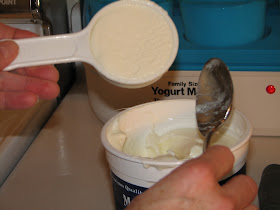
While I was shopping I also found the book "Stocking Up III" for $2.00. The book included six pages of information on Homemade Yogurt with great instructions and recipes.
When I arrived home I gave the yogurt maker a complete and thorough cleaning. Then I researched online to find instructions on how to use my new acquisition. While I didn't find the exact instructions for this particular model, I did find many articles online about the yogurt making process. It isn't necessary to use a yogurt maker, it just makes it a little more convenient. You can make yogurt in your oven, a Thermos, or even on a heating pad!
This morning I decided to try my hand at making homemade yogurt. The recipe calls for warm water; instant nonfat dry milk; and fresh, unflavored yogurt (with live cultures.)
Here's a little tutorial:

The yogurt machine needs to be plugged in to begin warming up first thing.

Assemble the ingredients: Warm water, instant nonfat dry milk, and fresh yogurt (with live cultures.)

Next, combine the warm water (110 to 115 degrees F.) and dry milk in a medium-sized pan and mixed thoroughly.

Once the water and milk are thoroughly mixed, add the yogurt and stir well.

Mix thoroughly.

Make sure the temperature is between 110 and 115 degrees F.

Pour the mixture into the glass yogurt cups. Divide the amount up evenly into the five cups.

Cover glass containers with lids (or improvise and use plastic wrap with elastics like I did -- out of necessity.)

Put on unit lid.

"After 4 hours, check one of the containers and tilt it gently. If the yogurt is thick, about the consistency of heavy cream, it is ready.
"Refrigerate the containers.
"If the yogurt is still rather watery, allow it to incubate for another hour, then check again. The longer the mixture incubates, the stronger and more sour the final result will be." (Stocking Up III, pgs. 390-391.)
*UPDATE: It took 9 hours for mine to thicken up. I read later that I should have poured the mixture through a strainer as I was pouring it into the glass jars. I did this after the nine hours incubation period. We'll see how it turns out. It's now cooling down in the refrigerator.
Here's the recipe I used:
THICKER YOGURTOne of the articles I read had a great idea for keeping fresh yogurt starter on hand (http://hillbillyhousewife.com/yogurt.htm.) She froze the store-bought yogurt (with live cultures) in ice cube trays. Once frozen, pop cubes out of trays and store in zipper-top freezer bags in the freezer until ready to use.
4 cups warm water (110 to 115 degrees F.)
2 1/3 cups instant nonfat dry milk
1/4 cup fresh, unflavored yogurt (with live cultures) or 1 package yogurt starter
Combine water and dry milk in a medium-size bowl and mix thoroughly. Stir in the yogurt or starter. Incubate using any method you like.
(Source: "Stocking Up III", by Carol Hupping and the staff of the Rodale Food Center, pg. 390)
I measured 1/4 cup water to see how many frozen cubes it would take. One-fourth cup water filled two cube sections using my particular ice cube trays and measuring cup. Experiment with your own to get an accurate amount.
Homemade Yogurt sites:
http://hillbillyhousewife.com/yogurt.htm
http://fiascofarm.com/dairy/yogurt.htm
http://www.101cookbooks.com/archives/000176.html
TIP: When shopping at a thrift store, look at things with an eye for their "potential." Sometimes with a little cleaning up and/or fixing items you can find real treasures!
TESTING COMMENT: I personally didn't care for how it turned out. I'm going to try a different recipe...try, try again.
TRY, TRY AGAIN...RESULTS: (January 29, 2009) I followed the suggestion from "anonymous" in the comment section and a different recipe. It turned out great! (Thanks "anonymous"!) I used the recipe from http://fiascofarm.com/dairy/yogurt.htm and tried microwaving 3 1/2 cups milk until it reached 120 degrees F. and let it cool to 115 degrees F. before adding it to the tablespoon of yogurt (with live cultures) in the bottom of each cup. After four hours in the yogurt maker, it was ready to eat. :) I'll definitely be making homemade yogurt again.
Great find! Today I picked up an 8 qt canner, like new, for $5.
ReplyDeleteI love thrift stores!
Wow! That's a great deal! Don't you just love bargains!
ReplyDeletewhen I was making yogurt in an appliance like yours, my instructions had me put a tablespoon of yoghurt in the glass jars, then add the warm milk mixture and stir. Add the lids and let incubate. I never had a failure and also found that a long incubation period made the yogurt too tangy for my family. We added some honey, mixed with orange juice and drank it.
ReplyDeleteThanks for the suggestion! I'll give it another try. :)
ReplyDeleteI've been making homemade yogurt for about a year now--I incubate it in my oven. I've found that Mountain High and Horizon are not the best starters (nor is any yogurt with added pectin or gelatin). The texture of the resulting yogurt is very poor--pretty much inedible. Trader Joe's has great starter yogurts. Dannon has worked well, too. Thanks for sharing your experiences! I'm showing the gals at church how to make yogurt this week--it's so easy and saves a lot of money.
ReplyDeleteThanks for the tips! I'll give them a try. :) Best wishes with your class this week!
ReplyDelete